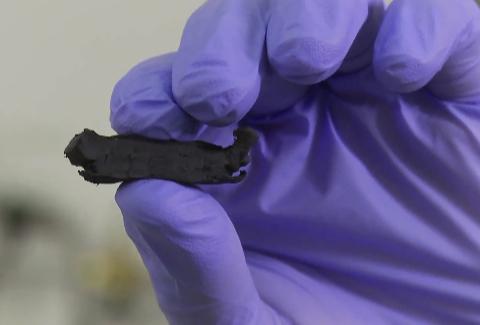 A handy reusable nanosponge has been developed that can quickly absorb oil spilled in water and can be manipulated by magnets. A team of researchers from Rice University and Penn State University working in conjunction with colleagues at laboratories in the U.S., Spain, Belgium and Japan have developed the nanosponge material using a process similar to that which is used to grow multiwalled carbon nanotubes. In order to turn what is essentially a set of tubes with no real connections between each other into a sponge, they added boron, which changes the way that the nanotubes grow. Instead of growing straight up, the nanotubes develop kinks and elbows and covalent bonds form between the tubes. The nanosponges, which are 99 percent air, are the end result. The nanosponges have two distinct properties that make them useful for cleaning up oil spills: they are superhydrophobic (they repel water, which makes them float very well) and they are oleophilic (they are attracted to oils). Another benefit is they can be wrung out and reused – in laboratory tests, the nanosponges retained their elastic property after 10,000 compressions. The oil can also be burned off from within the sponge before reuse. The magnetic property of the nanosponges offers two potential benefits: the sponges can be moved magnetically, allowing a clean-up team to direct an oil spill using strategically placed sponges; and the sponges can be collected magnetically, which allows for efficient retrieval. Rice graduate student Daniel Hashim explained that the super-low density of the nanosponges gives them a high volume that is able to absorb more than a hundred times their weight in oil. The next challenge for Hashim is to develop a technique for welding large sheets of nanosponges together, which would make them more effective in mopping up surface spills. Yet the research team believes their new material could have a variety of uses beyond cleaning up oil spills. Penn State University professor Mauricio Terrones suggested that they could be used to produce batteries that are lighter and more efficient, or could be scaffolds for bone-tissue regeneration, and could be impregnated with polymers to produce strong lightweight composites for use in automobiles and aircraft. If you want to read more about nanosponges, the team has published the study results in the article, “Covalently bonded three-dimensional carbon nanotube solids via boron induced nanojunctions” on Scientific Reports, an open access section of Nature. http://www.youtube.com/watch?feature=player_embedded&v=OCKyMn-2edo
A handy reusable nanosponge has been developed that can quickly absorb oil spilled in water and can be manipulated by magnets. A team of researchers from Rice University and Penn State University working in conjunction with colleagues at laboratories in the U.S., Spain, Belgium and Japan have developed the nanosponge material using a process similar to that which is used to grow multiwalled carbon nanotubes. In order to turn what is essentially a set of tubes with no real connections between each other into a sponge, they added boron, which changes the way that the nanotubes grow. Instead of growing straight up, the nanotubes develop kinks and elbows and covalent bonds form between the tubes. The nanosponges, which are 99 percent air, are the end result. The nanosponges have two distinct properties that make them useful for cleaning up oil spills: they are superhydrophobic (they repel water, which makes them float very well) and they are oleophilic (they are attracted to oils). Another benefit is they can be wrung out and reused – in laboratory tests, the nanosponges retained their elastic property after 10,000 compressions. The oil can also be burned off from within the sponge before reuse. The magnetic property of the nanosponges offers two potential benefits: the sponges can be moved magnetically, allowing a clean-up team to direct an oil spill using strategically placed sponges; and the sponges can be collected magnetically, which allows for efficient retrieval. Rice graduate student Daniel Hashim explained that the super-low density of the nanosponges gives them a high volume that is able to absorb more than a hundred times their weight in oil. The next challenge for Hashim is to develop a technique for welding large sheets of nanosponges together, which would make them more effective in mopping up surface spills. Yet the research team believes their new material could have a variety of uses beyond cleaning up oil spills. Penn State University professor Mauricio Terrones suggested that they could be used to produce batteries that are lighter and more efficient, or could be scaffolds for bone-tissue regeneration, and could be impregnated with polymers to produce strong lightweight composites for use in automobiles and aircraft. If you want to read more about nanosponges, the team has published the study results in the article, “Covalently bonded three-dimensional carbon nanotube solids via boron induced nanojunctions” on Scientific Reports, an open access section of Nature. http://www.youtube.com/watch?feature=player_embedded&v=OCKyMn-2edo Nanosponges Can Soak Up Oil Spills
 A handy reusable nanosponge has been developed that can quickly absorb oil spilled in water and can be manipulated by magnets. A team of researchers from Rice University and Penn State University working in conjunction with colleagues at laboratories in the U.S., Spain, Belgium and Japan have developed the nanosponge material using a process similar to that which is used to grow multiwalled carbon nanotubes. In order to turn what is essentially a set of tubes with no real connections between each other into a sponge, they added boron, which changes the way that the nanotubes grow. Instead of growing straight up, the nanotubes develop kinks and elbows and covalent bonds form between the tubes. The nanosponges, which are 99 percent air, are the end result. The nanosponges have two distinct properties that make them useful for cleaning up oil spills: they are superhydrophobic (they repel water, which makes them float very well) and they are oleophilic (they are attracted to oils). Another benefit is they can be wrung out and reused – in laboratory tests, the nanosponges retained their elastic property after 10,000 compressions. The oil can also be burned off from within the sponge before reuse. The magnetic property of the nanosponges offers two potential benefits: the sponges can be moved magnetically, allowing a clean-up team to direct an oil spill using strategically placed sponges; and the sponges can be collected magnetically, which allows for efficient retrieval. Rice graduate student Daniel Hashim explained that the super-low density of the nanosponges gives them a high volume that is able to absorb more than a hundred times their weight in oil. The next challenge for Hashim is to develop a technique for welding large sheets of nanosponges together, which would make them more effective in mopping up surface spills. Yet the research team believes their new material could have a variety of uses beyond cleaning up oil spills. Penn State University professor Mauricio Terrones suggested that they could be used to produce batteries that are lighter and more efficient, or could be scaffolds for bone-tissue regeneration, and could be impregnated with polymers to produce strong lightweight composites for use in automobiles and aircraft. If you want to read more about nanosponges, the team has published the study results in the article, “Covalently bonded three-dimensional carbon nanotube solids via boron induced nanojunctions” on Scientific Reports, an open access section of Nature. http://www.youtube.com/watch?feature=player_embedded&v=OCKyMn-2edo
A handy reusable nanosponge has been developed that can quickly absorb oil spilled in water and can be manipulated by magnets. A team of researchers from Rice University and Penn State University working in conjunction with colleagues at laboratories in the U.S., Spain, Belgium and Japan have developed the nanosponge material using a process similar to that which is used to grow multiwalled carbon nanotubes. In order to turn what is essentially a set of tubes with no real connections between each other into a sponge, they added boron, which changes the way that the nanotubes grow. Instead of growing straight up, the nanotubes develop kinks and elbows and covalent bonds form between the tubes. The nanosponges, which are 99 percent air, are the end result. The nanosponges have two distinct properties that make them useful for cleaning up oil spills: they are superhydrophobic (they repel water, which makes them float very well) and they are oleophilic (they are attracted to oils). Another benefit is they can be wrung out and reused – in laboratory tests, the nanosponges retained their elastic property after 10,000 compressions. The oil can also be burned off from within the sponge before reuse. The magnetic property of the nanosponges offers two potential benefits: the sponges can be moved magnetically, allowing a clean-up team to direct an oil spill using strategically placed sponges; and the sponges can be collected magnetically, which allows for efficient retrieval. Rice graduate student Daniel Hashim explained that the super-low density of the nanosponges gives them a high volume that is able to absorb more than a hundred times their weight in oil. The next challenge for Hashim is to develop a technique for welding large sheets of nanosponges together, which would make them more effective in mopping up surface spills. Yet the research team believes their new material could have a variety of uses beyond cleaning up oil spills. Penn State University professor Mauricio Terrones suggested that they could be used to produce batteries that are lighter and more efficient, or could be scaffolds for bone-tissue regeneration, and could be impregnated with polymers to produce strong lightweight composites for use in automobiles and aircraft. If you want to read more about nanosponges, the team has published the study results in the article, “Covalently bonded three-dimensional carbon nanotube solids via boron induced nanojunctions” on Scientific Reports, an open access section of Nature. http://www.youtube.com/watch?feature=player_embedded&v=OCKyMn-2edo 
